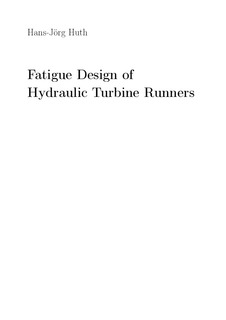| dc.contributor.author | Huth, Hans-Jörg | nb_NO |
| dc.date.accessioned | 2014-12-19T12:26:04Z | |
| dc.date.available | 2014-12-19T12:26:04Z | |
| dc.date.created | 2005-01-17 | nb_NO |
| dc.date.issued | 2005 | nb_NO |
| dc.identifier | 125212 | nb_NO |
| dc.identifier.isbn | 82-471-6899-5 | nb_NO |
| dc.identifier.uri | http://hdl.handle.net/11250/241313 | |
| dc.description.abstract | Turbine runners experience start-stop cycles and vibration cycles. Cracks initiated from service or manufacturing defects and propagated by start-stop cycles become critical when the stress intensity range due to vibrational loading exceeds the threshold for fatigue crack growth.
In Francis turbine runners, semi-elliptical surface cracks tend to propagate from the quarter-circular transition of the welded T-joint transition between the blade and the band or crown. Assuming a crack to grow under a constant stress amplitude equal to that at the most highly loaded location at the welded joint between the blade and the band or crown of a Francis turbine runner yields a conservative estimate of the life of the runner. A more accurate prediction of fatigue life is obtained by considering the growth of a crack in the real, inhomogeneous stress field. For an idealised T-joint under pure bending, the stress field has been determined by means of plane strain finite element analysis.
Finite element models of the entire Francis runner are built with respect to the calculation of fluid dynamic properties. Since in these models geometry transitions are modelled as a sharp notch, both a finite and a zero transition radius have been modelled, and the influence of the mesh size on the maximum stress has been investigated.
For relatively small cracks, it is shown that the structural component geometry does not remarkably influence the stress intensity factor values, provided that the stress field in the vicinity of the crack is approximately the same. Therefore, in order to simplify the stress intensity factor retrieval and to generate a solution of extended applicability, a cracked finite-thickness plate is examined instead of the actual T-joint geometry. The stress intensity factors along the front of a semi-elliptical surface crack in such a plate are determined by means of an analysis using finite quarter-point wedge elements for different elementary loading conditions that can be employed to model the actual stress field at the expected crack location in the examined T-joint. By applying the superposition principle and the power series expansion of the actual stress field due to the load applied to the T-joint considered, an approximate stress intensity factor for the cracked T-joint has been obtained.
The growth of semi-elliptic surface cracks in the stress field of the T-joint has been analysed using stress intensity factors of both own and literature solutions and employing a two-parameter model based on the Paris law. The theoretical fatigue crack growth predictions are in acceptable agreement with observations from experimental fatigue testing. Furthermore, an iterative shape optimisation methodology has been applied to the two locations of stress concentration that show the highest local stress amplitudes and therewith are the most critical areas for fatigue of the Francis turbine runner. It is shown that stress concentration due to bending can be virtually eliminated. Large-scale geometry changes minimise stress concentration but create shapes that are sensitive to manufacturi ing tolerances. Fracture-mechanical fatigue crack growth methodology calculations and experimental fatigue testing of moderately optimised shapes revealed that the runner’s fatigue properties could be increased by factors 1.5–1.8 and 2–2.5, respectively. | nb_NO |
| dc.language | eng | nb_NO |
| dc.publisher | Fakultet for ingeniørvitenskap og teknologi | nb_NO |
| dc.relation.ispartofseries | Doktoravhandlinger ved NTNU, 1503-8181; 2005:19 | nb_NO |
| dc.title | Fatigue Design of Hydraulic Turbine Runners | nb_NO |
| dc.type | Doctoral thesis | nb_NO |
| dc.contributor.department | Norges teknisk-naturvitenskapelige universitet, Fakultet for ingeniørvitenskap og teknologi, Institutt for produktutvikling og materialer | nb_NO |
| dc.description.degree | dr.ing. | nb_NO |
| dc.description.degree | dr.ing. | en_GB |
